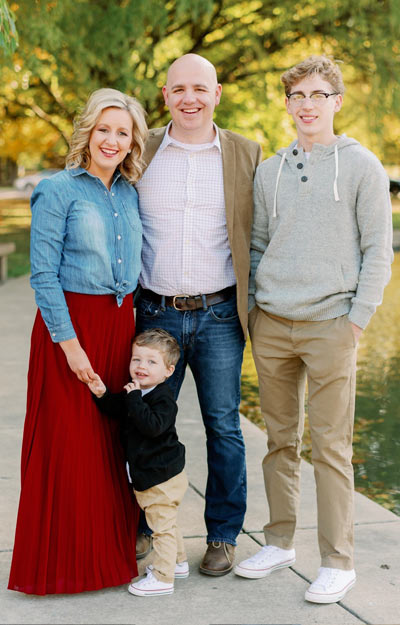- Home
- Patient Stories
- Microvascular Reconstructive Surgery - Patrick McNeil
Reconstructive Microvascular Surgery
By: Crystal Huff

“If it wasn’t for Washington University Orthopedics and Barnes-Jewish Hospital, I would have lost my leg!” states Patrick McNeil.
In December of 2018, while running up steps, Patrick missed the top step and fractured his right tibia. A simple fracture for most became a critical break for Patrick because when he was three, he was diagnosed with bone cancer. Despite being in remission for decades, the long term effects of the cancer treatments had left his leg weakened, and more susceptible to fractures.
“As a child and teen, I had had fractures but was told they did not want to perform surgery because it might only weaken my already fragile bones.”
Patrick first sought treatment at a community hospital and the surgery and treatment plan failed.
After surgery, Patrick was sent to physical therapy and was told he was healed; however, he was convinced something was not right. After several post-surgical and therapy visits, he discovered that his leg was still broken. He decided to get a second opinion.
Patrick reached out to Douglas McDonald, MD, a musculoskeletal oncology specialist with Washington University Orthopedics who had been his physician during his cancer treatment. Dr. McDonald recommended Patrick see his colleagues Martin Boyer, MD, FRCS(C), and David Brogan, MD, MSc. Both are hand and microsurgery specialists with expertise in bone and soft tissue reconstruction using microvascular reconstructive surgery.
“Patrick's tibia received radiation as a part of his cancer treatment years ago. The radiation essentially kills the bone as well as the tumor cells making the bone not only susceptible to fracture but leaving it with little biologic potential to heal on its own. Not only did we need to correct the alignment of his fractured bone we needed to add some healthy, living bone to ensure that it healed. Dr. Boyer and his team have the expertise to transfer a vascularized fibular graft to the nonunion site,” explains Dr. McDonald.
“I was able to get an appointment with Dr. Boyer within a week and I was scheduled for surgery within two to three weeks,” says Patrick.
Dr. Boyer says, “The problem with Patrick’s tibia was that until we were able to bring in new blood supply to his previously radiated bone, Patrick’s fracture would never heal. It became imperative to transfer healthy bone using microsurgical techniques in order to accomplish this.”
On April 15, 2019, Patrick underwent an eight hour surgery to repair his leg. Dr. Boyer explains, “Dr. Brogan and I transferred Patrick’s fibula from his normal leg, along with the artery and veins that give the fibula its blood supply, and some skin and soft tissue to keep it covered, to his broken leg. We used the microscope to attach the blood vessels in the fractured leg so that the transfer could begin to heal immediately.”
Patrick says, “Dr. Boyer, his nurse and his entire team were unbelievable. We were blown away by how nice and thorough they were.”
Patrick says he was given the cell phone numbers for Dr. Boyer and his team and they were in constant contact to answer any and all questions and ease concerns. There was an instance when Patrick was concerned about a possible complication, and reached out to Dr. Boyer’s nurse, Sarah Rock. “Within the hour I was being seen by Sarah while Dr. Boyer was on the phone and had surgery that very afternoon.”
Patrick is on his way to a full recovery. In August, he was fully released by Dr. Boyer and partially released from Dr. McDonald. “I am allowed to walk but no running. I’ve spent the last eight months on crutches and with having a traveling sales job and two sons, a two-year-old and a 17-year-old, it has been a very difficult. I am finally able to get back to playing with my sons and am looking forward to getting back to playing some golf.”
More Info: